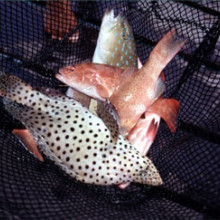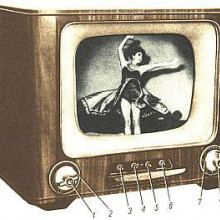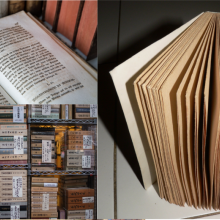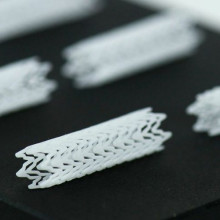This week, do diet foods make children fat? Could a space screw save us from catastrophe collisions? Have we seen the last of the Yangtze river dolphin? And should we look to the Simpsons for our science? Writer Al Jean explains that, despite the three eyed fish and three fingered hands, it's one of the most science literate shows on television. Also, as it's our Summer Special Question and Answer show we tackle your questions ranging from rising cakes to rising heart rates, why the moon looms larger on the horizon and why magnets make bad television. Plus, in kitchen science we investigate the mystery of Mr Matey's colour changing bubble bath!
In this episode

- "Whats Science Ever Done for Us?" What the Simpsons Can Teach Us About Physics, Robots, Life and the Universe
"Whats Science Ever Done for Us?" What the Simpsons Can Teach Us About Physics, Robots, Life and the Universe
with Professor Paul Halpern, University of Philadephia
Chris - "What's Science ever done for us" is also the title of a new book that's out at the moment. It's been written by Professor Paul Halpern, he's from the University of Philadelphia. He joins us now. Hello Paul.
Paul - Hello Chris.
Chris - Thank you for joining us on the naked scientists to tell us about your book. Why have u written this? And don't say to make money because that was Boris Johnson's answer on Radio 2 the other day.
Paul - Well I noticed throughout the years that the Simpson's features marvellous Scientific references on the show and features scientific guests and many illusions to people such as Neil spore, Einstein, Darwin and Newton...I thought it was about time to look at the Simpson's episodes and explore the real science behind the series.
Chris - Well, few people have the sort of insight into how you've done this, it's nice this because you get a taste of the Simpson's upfront and then you get how it's relevant to science in the second part of the chapter.
Paul - That's right in each chapter I look at how an episode of the Simpson's handles the science then I look at the background behind it. For example, in one episode Lisa invents her own perpetual motion machine and Homer gets obsessed by it and shouts at her: "Lisa, in this house we obey the laws of thermodynamics." So I take off from that episode into an exploration of whether or not perpetual motion is possible and I explore the laws of thermodynamics. So I find it provides a great intro into some interesting science.
Chris - Now, how does the Simpson's sit with you as a professional physicist engaged in research in a US university?
Paul - Well, physicists that watch televisions tend to enjoy series like the Simpson's because it's one of the few series, it's not the only series, to have scientific references on the show and it does a number of fun and very sophisticated things with science. For example, exploring higher dimensions, looking into the possibility of time travel, bringing up genetics, robots, artificial intelligence... it's just amazing how much interesting science there is in the show.
Chris - I thought it was hilarious when Homer Simpson managed to end up crossing a tomato and tobacco plant to make an addictive form of a tomato
Paul - That's right it's called Tomacco and the interesting thing is he uses plutonium to make this hybrid
Chris - And he gets it where..?
Paul - [laughs] He manages to get it shipped in from his nuclear plant, it's no problem for him since he works in this plant so he just manages to phone up his friend and get some plutonium shipped into his farm that he's trying to grow crops on. He grows this tomacco and produces this tomacco plant, which is highly addictive.
Helen - I don't know if this is in your book but one of my favourite bits in one of the shows is when they discover that Homer, as a young child, pushed a crayon up his nose and into his brain and that's why he's... 'Homer' shall we say. They take it out and he becomes very intelligent and then they decide in the end to put it back again. Do you think, is there any reality in having a pencil in your brain and changing your behaviour?
Paul - Well it's interesting. The Simpson's brings up a number of theories throughout the years on why Homer is so different than the people in his family, for example Lisa, who is much brighter and in one episode they attribute it to genetics. Then, in the episode called 'Homer' which is a parody of Flowers for Algernon, they suggest it's an accident that Homer had as a child where he had the crayon lodged in his brain and that it affected his intelligence, but the strange thing is once they pull out the crayon he's very unhappy. He preferred being not so bright
Chris - I think that goes for a lot of people in some cases though doesn't it? I mean, not that everyone would have a crayon jammed up their brain but some people find that ignorance is bliss don't they?
Paul - That's right sometimes u can know too much about a subject and you might not be happy about it, you'll be well informed but perhaps not particularly happy about if say you know that something dyer is going to happen
Chris - Well Paul, I have to say I thoroughly enjoyed your book. It had me sniggering at midnight last night so thank u for sending us a copy. Thank you for joining us on the Naked Scientists to tell us about it. It's out now is that right?
Paul - That's right. Yes. Thank you very much. It's my pleasure.
Chris - It's been a pleasure to have you on the programme. Thank you
Paul - Bye
Chris - That's Professor Paul Halpen. He's written a book called "What's Science ever done for us". It's all about how the Simpson's, as we've been exploring, actually has its firm roots in science and you can get it in all good bookshops right now.
Diet foods make children fat
US researchers have found that giving young animals diet foods can trigger obesity by encouraging overeating behaviours, suggesting that the same thing could happen to young children. Writing in the journal Obesity, University of Alberta researcher David Pierce and his colleagues have found that giving young rats the rodent equivalent of low-calorie foods affected their ability to learn how to associate the amount of energy in food with its taste. It seems that artifical sweeteners can fool the brain into assuming that all sweet things are equivalently low in calories, which can trigger over-eating when other non-diet foods are consumed. In the present experiments the age of the animals also seemed to be critical, because adolescent rats were not affected, possibly because they had already established the relationship between tastes and calories. "One thing is clear at this point," says Pierce, "our research has shown that young animals can be made to overeat when low-calorie foods and drinks are given to them on a daily basis, and this subverts their bodies' energy-balance systems." The results also fit with other recent findings including a University of Massachusetts study which showed links between diet drink consumption (amongst children) and obesity, diabetes and heart disease. "Diet foods are probably not a good idea for growing youngsters," Pierce cautions.
Perseids Meteor Shower
If you happen to look up tonight you ahould be in for some cosmic fireworks. It is the peak of the Perseid Meteor Shower tonight and it is a new moon so the sky should be very dark so the meteors stand out really well, teh best conditions for the next 15 years in fact.
The Perseids are so called because they appear to be coming out of the constellation Perseus and occur at about this time most years. They are the dust and debris left from the comet Swift-Tuttle as it orbits the sun. The densest region of which that we are passing though tonight dates from 1862.
The perseid meteors are small lumps of dust or rock that hit the earth at 132 000mph. This means that they heat up immensely as they tear into the atmosphere, in a similar way to how your hands heat up when you rub them together.. They heat up to several thousand degrees celcius so hot that they glow white hot, creating a shooting star.
Although not as intense as tonight the perseids should carry on for the next couple of weeks, so find yourself somewhere away from the lights, lie down and look for the shooting stars.
Wave goodbye to the reefs.
We often hear about coral reefs being the rainforests of the sea - both habitats are packed full of thousands of species and sadly both are being lost at ever more alarming rates.
And this week we've heard a piece of really bad news for coral reefs, because they may be disappearing much more quickly than we thought they were, and possibly around twice as fast as rainforests.
That's according to a new study from John Bruno and Elizabeth Selig at the University of North Carolina in the United States.
They collected together over six thousand other studies going back to 1968 that documented how much hard coral was growing on particular coral reefs in the Indian and Pacific Oceans, in countries including Indonesia, Australia and the Philippines.
Hard corals are the building blocks of reefs - also known as scleractinia - they provide the main structure and habitat for all the other animals and plants to live on. Measuring the percentage of the reef that hard corals cover is one of the best ways of gauging how healthy a reef is. [It's a little bit like measuring how much canopy a rainforest has from either air born or satellite images, which is how scientists measure how quickly forests are being lost.]
The bad news is that the coral cover on reefs in the Indian and Pacific Oceans over the last 20 years has dropped by an average of 1% every year which might not sound a lot but it's the equivalent of around fifteen hundred square kms every year.
The study also discovered that reefs in the Indian and Pacific oceans also began declining much earlier than we used to think - it was always thought that reefs on the other side of the planet in the Caribbean were in the worst state, but now it seems the Indo-Pacific is also fairing just as badly.
The cause of these declines could be a combination of global factors, like increased sea surface temperatures that trigger devastating bouts of coral bleaching, as well as more local pressures like damaging fishing techniques and the run off of sediments and pollutants from land.
But it's not all doom and gloom. The researchers found that a number of reefs have in fact been increasing in coral cover, showing that it's not too late, especially if we start taking direct action to stop the decline continuing at all these different levels from local to global.
Protecting reefs makes nothing but good sense. Not only do the reefs of the Indo-Pacific contain huge numbers of species, the reefs also provide a crucial source of protein for people in many developing countries, they help protect coastlines from erosion and the generate important income in countries with burgeoning tourism industries.
Nuclear Space Screw Tackles NEOs
Although space scientists are confident that they have mapped the majority of "near Earth objects" that could conceiveably collide with us, and found that we're safe for now, there's always the possiblity that something unexpected might happen. Like the asteroid Apophis, which will slip past the Earth in 2029, and then make a return visit in 2036. If it alters its course there is a remote one in forty-five thousand chance that it could hit us.
Thankfully, University of Rome La Sapienza researcher Daniele Fargion has come up with a new strategy to tackle the problem head on - a nuclear powered rocket drill which burrows into the object and hurls the rock it digs out into space, pushing the asteroid off its Earth-bound course. This is an application of Newton'sThird Law - for every action there is an equal and opposite reaction. Flinging the drilled-out debris into space will give the object a kick in the other direction. Fargion's calculations show that over a ten year period this could deflect a 1 kilometre asteroid by upto 30,000 kilometres, enough to miss the Earth. But it's not all plain sailing. Asteroids are often loose aggregations of rocks and debris, which may prove difficult to drill into. Another problem is that they are also very often spinning, so the system would have to be programmed to spit out rocks only when the asteroid was pointing in the right direction. Undeterred, however, Fargion proposes testing the idea on our own moon, where his "screw rockets" could help to dig out underground shelters for future human use.
Bye bye River Dolphin?
I don't mean to be the harbinger of bad news - but it happens this week we've had another piece of important but incredibly depressing news from the aquatic world.
It looks like we might have to wave goodbye to the Yangtze river dolphin in China. Researchers from Zoology Society of London (ZSL) reported that during a two month expedition along the Yangtze river they found absolutely no trace of these dolphin.
The researchers have pointed the finger of blame at unregulated fisheries that accidentally caught the river dolphins, as well as the construction of dams and collisions with the huge amount of boat traffic that now ply the waters of the Yangtze river. They proclaimed this as could be the first cetacean to be driven extinct at the hand of mankind and the first extinction of a large vertebrate for over fifty years - so it's the first time a large, charismatic creature has disappeared from the planet that most of us will remember.
Facts about the Yangtze river dolphin:
- It was the only remaining member of an entire branch of the evolutionary tree, called the Lipotidae, a group of mammals that separated from other marine mammals around 40-20 million years ago.
- If any Yangtze river dolphins had been found during ZSL's expedition, they would have been taken to an oxbow lake to begin a captive rearing programme.
- The Yangtze river dolphin had a long narrow beak which it used to feed on fish.
- The Yangtze river dolphin was top of the list on ZSL's EDGE programme, which stands for "Evolutionarily Distinct and Globally Endangered species" - the world's mammals were ranked in terms of how distantly related each one is to it's nearest neighbour and how engendered they are.
- The extinction of the Yangtze river dolphin highlights the threats faced by other rare and endangered species in the river ecosystem which includes endangered freshwater porpoises, giant salamanders and Siberian cranes.
Is a high heart rate when exercising normal?
There are lots of things that can increase your heart rate, such as drinking caffeinated drinks or alcohol, or even having an heated argument! The heart should match the beat rate to the demands of your body, so that the right amount of blood gets pumped. If you pump too little blood your tissues become starved, but if you pump too much you're wasting energy. There are some medical conditions that can make the heart pump too fast, but usually they don't cause the heart to go fast all the time.It's hard to say what's a 'normal' heart rate, as diet and level of fitness can really make a big difference.

Why Does Bubble Bath Change Colour
Why does the moon on the horizon look bigger?
When the moon is low on the horizon you are looking through more atmosphere, but although this can have the effect of making the moon look orange (because blue light is scattered), and can distort the shape of the moon, this does not make it look bigger. Actually, it's all a matter of perception - you can see other objects near the moon, such as trees or building on the horizon, so your brain interprets the moon as being bigger. If you were to view the moon through a cardboard tube, and so cut out all the surroundings, you would perceive it as being exactly the same size as it is when you look straight up!

Why can you hear a humming sound inside your head?
There are two possibilities with this; noises you can hear that come out of nowhere could be tinnitus, which is caused when you have damage to your hearing system.
The damage removes the input of certain parts of the hearing spectrum, (you hear across a range of frequencies).
In the same way as some people get "phantom pain" in an amputated limb, the brain 'invents' some sound to make up for a lack of input from a part of the hearing system.
Tinnitus is normally a high pitched ringing noise, so probably not the cause of a droning sound.
The most likely explanation for a drone is that you have blood vessels in your ears, and these pulsate. In some situations, such as a very quiet room or when you put your head on a pillow and create a sound chamber in your ear, you can hear the sound of blood rushing through those vessels.

Have 90% of large fish disappeared?
We have had declines up to 90% of some fish, and over-fishing seems to be the main culprit.
Whether or not fish stocks can recover is a different matter, we may have altered the marine ecosystem so much that recovery might not be possible.
You may have heard that there's not much cod left in the sea, especially around Canada. A crash in cod numbers shut down many Canadian fisheries in the 1980s, but the numbers of cod have not recovered despite much lower fishing.
A caller also pointed out that, although trawlermen must throw back any juvenile fish - those below a certain size - often the nets damage or kill the small fish anyway, and so the damage is already done.
A better way would be to establish protected areas, but they may be prone to poaching. We currently only have about 1% of the Earth's ocean protected.

Why do magnets affect a tv screen?
This only works on old fashioned tv screens or computer monitors, so to understand why this happens we need to know how they work. Inside a television there is a big glass chamber which has had all the air sucked out to make a vacuum. At the back of this chamber is an electrical gun which fires electrons towards the back of the screen. The screen is covered with tiny lumps of phosphor, which glows when an electron hits it. If you cover the whole screen with one colour of phosphor, you get a black and white tv.
To make a colour tv screen, they put tiny spots of three different colours of phosphor on the screen in groups. Each group contains a spot of red, a spot of green and one of blue. Lighting these up in different combinations can make all the colours you see on your tv.
As electrons fly towards the screen, they can be moved using a magnetic field - this lets you aim the electrons at the right spot of phosphor and get the right colours in the right place.
When you put a magnet near the tv, it diverts the electrons away from where they should go, and so the wrong phosphor spots light up and you don't get the right colours.
Sometimes, if you put a magnet near a tv for too long, you can make bits of it magnetic and so it will always distort the colours: this is how the colours stay there.
Some tv's have a degaussing coil inside them that re-sets the magnetism when you switch them on, so the colours go back to being correct.
Even the Earth's magnetic field is enough to distort the colours, so if you turn a tv upside down when it's switched on, this can also make the colours go wrong.
We did this experiment in kitchen science.
27:57 - Scientific Springfield - The Science of the Simpsons
Scientific Springfield - The Science of the Simpsons
with Al Jean
Michael Hopkin: If you are looking for science on TV, you probably would not turn to a show about a dysfunctional cartoon family whose main intellectual thinker is an 8-year-old girl, but if you look closely, The Simpsons' is one of the most scientifically literate shows around and that is perhaps unsurprising given the fact that the shows head writer, Al Jean studied mathematics at Harvard. I asked him whether there are any parallels between cartoons and maths.
Al Jean: I look at comedy writing mathematically. You know it started like a proof for you trying to find the ideal punch line for a setup and when you get it, it is a very elegant feeling and it is a little like a feeling of completing a proof when I was doing math in college.
Michael Hopkin: And he is not alone, in fact, most of the established writers on this show have a scientific pedigree and it is a pretty impressive roll call.
Al Jean: Yes, Ken Keeler who wrote for The Simpsons and Futurama has a mathematical Ph.D., Bill Odenkirk who writes for The Simpsons has a Ph.D. in chemistry, George Meyer a long time Simpsons writer, I cannot remember what his major was, but it was definitely in the sciences and Stewart Burns another Simpsons and Futurama writer had maths degree, and you know when we are alone, you know, we sort of talk about math, but again we have learnt that there is a wider world and we do not always like, expose others to it. We do it in a subtle way.
Excerpt from The Simpsons: "I know. Well, this perpetual motion machine she made today is a joke. It just keeps going faster and faster. Lisa, get in here. In this house, we obey the laws of thermodynamics."
Michael Hopkin: There is also a scientific theme running through the new movie alongside typical Simpsons' absurdities such as Homer falling in love with a pig. The plot also features the looming threat of climate change prompting Lisa to present an Al Gore-style lecture entitled 'an irritating truth'. In fact, throughout the shows 400-episode history, it has often fallen to Lisa to speak up for scientific rationalism, perhaps most notably in the episode in which she attacks Springfield's decision to abandon the teaching of evolution. It made me wonder whether the writers have a specifically pro-science agenda.
Al Jean: Our general agenda is to display both sides of an issue and to let the viewer make up his or her own mind. In that particular case, I believe evolution is so scientifically well founded that it is hard to have any sort of intelligent alternative joy.
Excerpt from The Simpsons: "Creationism, but that is not science.""It is now. This helpful video will evade all your questions. Eyes screenward."
"So, you are calling god a liar an unbiased comparison of evolution and creationism. Let's say hi to two books; one a bible was written by our lord. The other, the origin of species was written by a cowardly drunk named Charles Darwin,"
"This is slander. Darwin was one of the greatest minds of all time!"
"Then, why is he making out with Satan?"
Michael Hopkin: Of course, The Simpsons also has fun with scientists' social image especially in the case of the painfully awkward professor Frink, who one suspects would trade in all of his inventions such as the sarcasm detector, the frog exaggerator, and mood pants for the chance just to get a girlfriend, but more seriously and as someone who has spent time in the scientific community, Al Jean worries about the negative portrayal of science and scientists in much of the mainstream media.
Al Jean: Well, it is sad because, you know, in my life I have seen science viewed as sort of the saviour for everything and it has almost come full circle, you know, because nothing can completely solve everybody's problems, the disappointment when that happens is extreme and now people are, you know, casting scientists as villains or, you know, not listening to them, which I think is tragic, you know, 50 years ago, Albert Einstein was the epitome of scientists among the public and regarded as a hero and there is not anybody comparable today and I think it shows how science has, you know, have been made to appear in a, you know, more ambiguous way.
Michael Hopkin: That is not to say that contemporary scientists have not appeared on the show. Over the years, The Simpsons has featured scientific luminary such as Stephen Jay Gould and Stephen Hawking and the writers have not been afraid to give them scripts that delve into the relevant subject matter.
Al Jean: There is nothing, you know, purer than mathematics of all the things I have ever studied. People seem really thrilled that we have had Stephen Hawking on the show and no one could be more thrilled than I.
Excerpt from The Simpsons: "Oh! Stephen Hawking!""The world's smartest man."
"What are you doing here?"
"I wanted to see your Utopia, but now I see it is more of a Fruitopia."
"I am sure what Dr. Hawking means..."
"Silence I don't need anyone to talk for me, except this voice box. You have clearly been corrupted by power. For shame"
"Larry Flynt is right! You guys stink!"
"I don't know which is the bigger disappointment, my failure to formulate a unified field theory or you."
Michael Hopkin: So, if you worry about science getting a bad reputation on TV, you can take solace in the fact that Springfield at least is on your side. That is assuming of course that you think science is worth caring about.
Excerpt from The Simpsons:"Science! What has science ever done for us? TV off"

34:10 - What's Science Ever Done for Us? - What the Simpsons Can Teach Us About Physics, Robots, Life and the Universe
What's Science Ever Done for Us? - What the Simpsons Can Teach Us About Physics, Robots, Life and the Universe
with Professor Paul Halpern, University of Philadephia
Chris - "What's Science ever done for us" is also the title of a new book that's out at the moment. It's been written by Professor Paul Halpern, he's from the University of Philadelphia. He joins us now. Hello Paul.
Paul - Hello Chris.
Chris - Thank you for joining us on the naked scientists to tell us about your book. Why have u written this? And don't say to make money because that was Boris Johnson's answer on Radio 2 the other day.
Paul - Well I noticed throughout the years that the Simpson's features marvellous Scientific references on the show and features scientific guests and many illusions to people such as Neil spore, Einstein, Darwin and Newton...I thought it was about time to look at the Simpson's episodes and explore the real science behind the series.
Chris - Well, few people have the sort of insight into how you've done this, it's nice this because you get a taste of the Simpson's upfront and then you get how it's relevant to science in the second part of the chapter.
Paul - That's right in each chapter I look at how an episode of the Simpson's handles the science then I look at the background behind it. For example, in one episode Lisa invents her own perpetual motion machine and Homer gets obsessed by it and shouts at her: "Lisa, in this house we obey the laws of thermodynamics." So I take off from that episode into an exploration of whether or not perpetual motion is possible and I explore the laws of thermodynamics. So I find it provides a great intro into some interesting science.
Chris - Now, how does the Simpson's sit with you as a professional physicist engaged in research in a US university?
Paul - Well, physicists that watch televisions tend to enjoy series like the Simpson's because it's one of the few series, it's not the only series, to have scientific references on the show and it does a number of fun and very sophisticated things with science. For example, exploring higher dimensions, looking into the possibility of time travel, bringing up genetics, robots, artificial intelligence... it's just amazing how much interesting science there is in the show.
Chris - I thought it was hilarious when Homer Simpson managed to end up crossing a tomato and tobacco plant to make an addictive form of a tomato
Paul - That's right it's called Tomacco and the interesting thing is he uses plutonium to make this hybrid
Chris - And he gets it where..?
Paul - [laughs] He manages to get it shipped in from his nuclear plant, it's no problem for him since he works in this plant so he just manages to phone up his friend and get some plutonium shipped into his farm that he's trying to grow crops on. He grows this tomacco and produces this tomacco plant, which is highly addictive.
Helen - I don't know if this is in your book but one of my favourite bits in one of the shows is when they discover that Homer, as a young child, pushed a crayon up his nose and into his brain and that's why he's... 'Homer' shall we say. They take it out and he becomes very intelligent and then they decide in the end to put it back again. Do you think, is there any reality in having a pencil in your brain and changing your behaviour?
Paul - Well it's interesting. The Simpson's brings up a number of theories throughout the years on why Homer is so different than the people in his family, for example Lisa, who is much brighter and in one episode they attribute it to genetics. Then, in the episode called 'Homer' which is a parody of Flowers for Algernon, they suggest it's an accident that Homer had as a child where he had the crayon lodged in his brain and that it affected his intelligence, but the strange thing is once they pull out the crayon he's very unhappy. He preferred being not so bright
Chris - I think that goes for a lot of people in some cases though doesn't it? I mean, not that everyone would have a crayon jammed up their brain but some people find that ignorance is bliss don't they?
Paul - That's right sometimes u can know too much about a subject and you might not be happy about it, you'll be well informed but perhaps not particularly happy about if say you know that something dyer is going to happen
Chris - Well Paul, I have to say I thoroughly enjoyed your book. It had me sniggering at midnight last night so thank u for sending us a copy. Thank you for joining us on the Naked Scientists to tell us about it. It's out now is that right?
Paul - That's right. Yes. Thank you very much. It's my pleasure.
Chris - It's been a pleasure to have you on the programme. Thank you
Paul - Bye
Chris - That's Professor Paul Halpen. He's written a book called "What's Science ever done for us". It's all about how the Simpson's, as we've been exploring, actually has its firm roots in science and you can get it in all good bookshops right now.
Why do streetlights mke the sky glow?
The light must be reflecting of something, and on a very dry night this could be dust. However in the UK the most likely candidate is water vapour - not dense enough see normally, more like a very light mist. This mist can form when moist air cools, and water condenses into a vapour, and is very likely the reason why you can see the town's lights on a clear night.

What makes a cake rise?
Self-raising flour contains baking powder, which is usually a mixture of bicarbonate of soda, cream of tartar and something called calcium aluminium phosphate.
Bicarbonate of soda has lots of carbon dioxide locked up in it, which is let out by reacting with an acid.
Cream of tartar becomes tartaric acid when it gets wet, so these then react together and produce bubbles of carbon dioxide in the cake, making the cake rise.
Calcium aluminium phosphate only becomes acidic when it gets to a certain temperature, giving extra bubbles, and so an extra rising stimulus, while the cake bakes.
What information do you get from CT images of the brain?
CT, or Computerised Tomography scanning technology was a massive breakthrough in medicine. It gave us the first 3-D views of the inside of the body without having to open people up. CT scans rely on x-rays, which pass through the body and different tissues absorb different amounts. Instead of shooting one x-ray straight through you, which gives a kind of x-ray shadow on a photographic plate, CT scanning shines lots of x-rays through the body at lots of different angles. By taking a picture from every one of these angles a computer can then work out how much of the x-rays were soaked up by each tissue they went through, from each angle. The computer can the use this information to build up a picture of what you look like inside in 3 dimensions.CT scans can be made even more sensitive by adding contrast - heavy atoms of things like iodine or barium that soak up lots of x-rays. This can help show up things like blood vessels compared to other tissue. CT is very useful for looking at things like stroke, where you can look in the brain and see if there's a blood clot or bleed - as blood contains a lot of iron is shows up quite well.

How does a stent open out when it’s put in there?
When you've got a blocked coronary artery, for example, in the heart, what people used to do was to stick a line in through the top of the leg, into the artery, thread it back to where the heart is, go into the blood vessels supplying the heart and then you inflate a tiny balloon inside the artery.
This opened up the artery by squashing the blockage which was making the artery narrow. When they did that to start with, what would happen is, very quickly the artery would block up, or fur up, again.
So then doctors discovered that the best approach is you if you deploy what's called a stent, which is like a metal scaffold.
Now it's very very tiny when you first put it in and it's threaded over the end of the balloon and when it gets to the right point in the artery where you want to deploy it, you inflate the balloon, which stretches the scaffold. It's almost like it ratchets out and locks in position. It props open the wall of the artery, stopping it constricting again and this should hold the problem area open and make sure it doesn't block again.
What is it in soap that kills all the nasties?
Soap is a very good way of cleaning your hands because its got oily molecules in it that will break down the membranes of microorganisms. All microorganisms are surrounded by an oily bag which separates the good things inside a cell from the environment outside. And because it's oily, if you've got some detergent or soap it can stick its wiggly chain into that oily bag, break it open and then bust open the bug. This is why soap actually works and detergents work. Physically rubbing your hands together also helps, as it detaches microorganisms when under a stream of water.









Comments
Add a comment